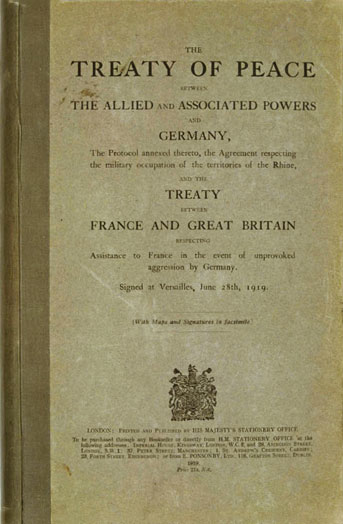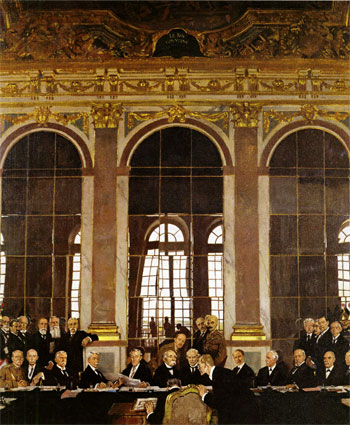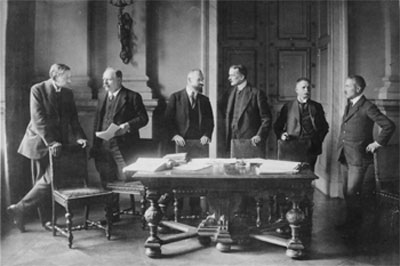 Source: Treaty of Versailles, Wikimedia.
Source: Treaty of Versailles, Wikimedia.
 Source: Treaty of Versailles, Wikimedia.
Source: Treaty of Versailles, Wikimedia.
The armistice ended the actual fighting of World War I, but the war did not end until the signing of the Treaty of Versailles. The Treaty of Versailles was the name given to the treaty hammered out by the Big Four at Paris between the Allies and Germany. Additional treaties were also written for peace between the Allies and the other Central Powers through the year 1920.
![]() Pay close attention while watching the following video about the Treaty of Versailles.
Pay close attention while watching the following video about the Treaty of Versailles.
![]() Each of the Big Four members is in the photo below. Click on name of each leader and drag it to the appropriate goal.
Each of the Big Four members is in the photo below. Click on name of each leader and drag it to the appropriate goal.
Answer the following questions in your notes.
 Source: William Orpen-The signing of peace of in the Hall of Mirrors, Wikimedia.
Source: William Orpen-The signing of peace of in the Hall of Mirrors, Wikimedia.
On June 28, 1919,when the Allies met in Versailles to formulate the treaty to end World War I with Germany and Austria-Hungary, most of Wilson's Fourteen Points were rejected by the leaders of England and France. Wilson was disappointed to learn that England, France, and Italy were mostly interested in regaining what they had lost and gaining more by punishing Germany. Germany was even more disappointed to learn that Wilson's peace plan did not apply to them.
![]() Here is a breakdown of the components of the Treaty of Versailles. Click on each component to learn more about the agreements made at the signing of the Treaty of Versailles.
Here is a breakdown of the components of the Treaty of Versailles. Click on each component to learn more about the agreements made at the signing of the Treaty of Versailles.

Source: Versailles deutsche Verhandlungedelegation, Wikipedia
This is a photo of the German delegates who participated in negotiations of the Treaty of Versailles.
President Wilson's plan for a just world peace was accepted by Germany in its entirety, but the leaders of Italy, France and Great Britain refused to give up their goals for retribution against Germany. Thus, many of its tenets were sacrificed at the peace conference.
Imagine that you are a German citizen and you have just learned about the terms of the Treaty of Versailles. In your notes, write a letter to the members of the German delegates to address the following questions.